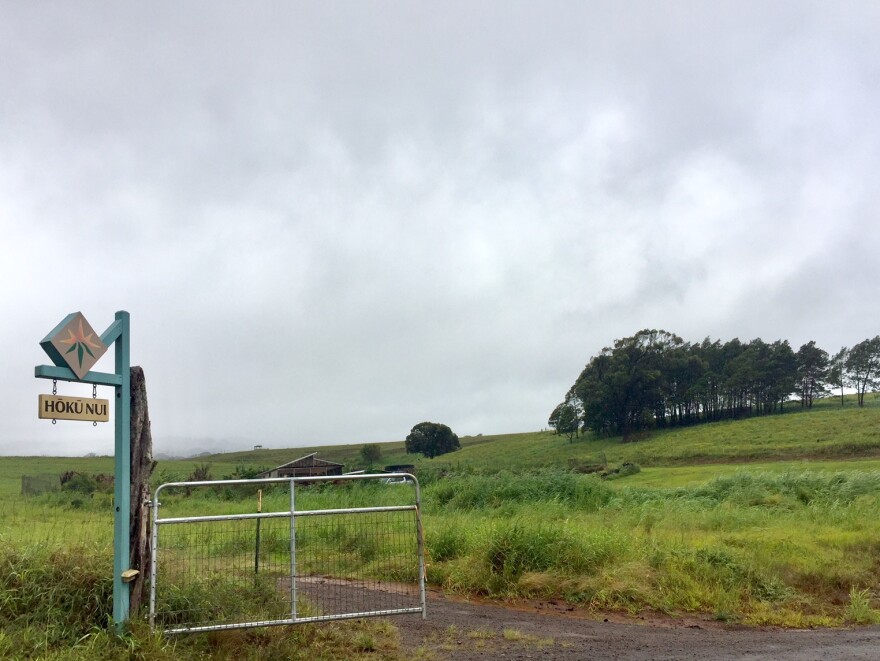Kumu Hula Keali‘i Reichel’s H?lau Ke‘alaokamaile has numerous awards to its credit, including being overall winner at Merrie Monarch in 2011. In an effort now to deepen their work, the H?lau is establishing a cultural center and joining in a larger effort to create a regenerative community on Maui. HPR’s Noe Tanigawa caught up with Reichel in that pastoral setting for a wide ranging conversation that included a tip for hikers in Hawaiian forests.

This is the first of two segments, the second, Friday, looks at Keali‘i Reichel's prototype for how Hawai’i’s hula h?lau can deepen their roots and expand their cultural influence. The extended interview here deals primarily with Hawaiian protocol and its nuances.
It’s a dirt and gravel road through fields of green onto the H?k? Nui property up Pi‘iholo, upcountry a bit from Makawao town on Maui. H?k? Nui is planning homes, forestry, ag lots, and a cultural center on the 258 acre property.
"We are in a place called Kapu‘au, right in the center of the H?k? Nui property, which is part of the Hamakuapoko moku, part of the Makawao ahupua‘a."
Kumu Hula Keali‘i Reichel surveys the green ridge where his H?lau Ke‘alaokamaile will build their new home. He is here, in part, to ensure the Hoku Nui project develops with Hawaiian values and culture.

Reichel: Recognizing a sense of place, reestablishing connection with the various winds and rains that are kama‘?ina to this place, and couple that with the actual topography of this land, which is hilly, which is not too cold, not too hot, not too rainy, except for today! Haha. Not too rainy, not too dry, we’re at a really good space in this particular area, in this place called Pi‘iholo, as we call it now.
The rain was our companion this day, as we sat round a table in the airy greenhouse, with beds of native plant seedlings all around us. Koa Hewahewa, the Director of Forestry Operations here at H?k? Nui, joined us. His is a Hawaiian approach to the land.
Hewahewa : I like what Keali‘i told me before, normalizing protocol. That is a big component that is missing from farming, from a lot of the things we’re doing. Whether it’s construction, hospitality industry, farming--- those are run with a Western concept.
Hawaiian protocol, Reichel says, is about connecting.

Reichel: I think protocol is a large catchall term. How do we approach, and to whom do we pay homage? Protocol is also how you approach a project. Culturally does it require ceremony? Does it require permission? Does it require a chant? Does it require certain actions and thought processes before it starts? Each event that utilizes quote unquote protocol is different, and everybody’s approach is different.
Beginning a project, approaching a home, would require protocols. How about for entering the forest? Is there something we should say?
Reichel: Say something. Greet the forest say, eh, howzit, dis me! I’m just one little speck in this huge universe of specks. As a Hawaiian I prefer that you chant, but not everybody know how for chant, and I would much rather you not chant if you don’t know the words correctly. If you don’t know the words correctly, don’t just make any kine, because for us, words are power. You utilize what power you have in your own system.
Hewahewa: I’d say, as much as you can, try and stay out of the forest. You gotta have a specific reason to go there. Our forest and our watershed is under a lot of threat. Whatever happens up ma uka always affects everything below it. Before hiking, before going into the forest, understand what it’s about. Understand the importance it holds for our ability to live here, to breathe here, to drink water here, to survive here, to continue to be here and for future generations to be here. If you going in there, make sure, m?lama.
Reichel: For us, we don’t go there, unless there’s a purpose. Why are you going in the forest? What is your purpose, and does your presence in the forest help the forest? Or is it detrimental?
Reichel: I see the attraction. There’s a human basic necessity to reconnect to the elements. You gotta shift your thinking, because I understand the need for people to go into the elements. For some people it’s the ocean. They feel better. For some people it’s the forest, when they go inside they feel like they’re a part of something bigger, although they cannot articulate it.
Reichel: But you have to be careful not to become myopic about it in the sense that I’m only doing this to reenergize my battery. Okay, great, the ocean went reenergize you and you feel all reborn, okay so what you going do in return? It’s a type of protocol I think, so What you going do?
Check the extended interview above for one Hawaiian perspective on sunbathing. Meanwhile, Friday, a look at Reichel’s prototype for how Hawai’i’s hula h?lau can deepen their roots and expand their cultural influence.





